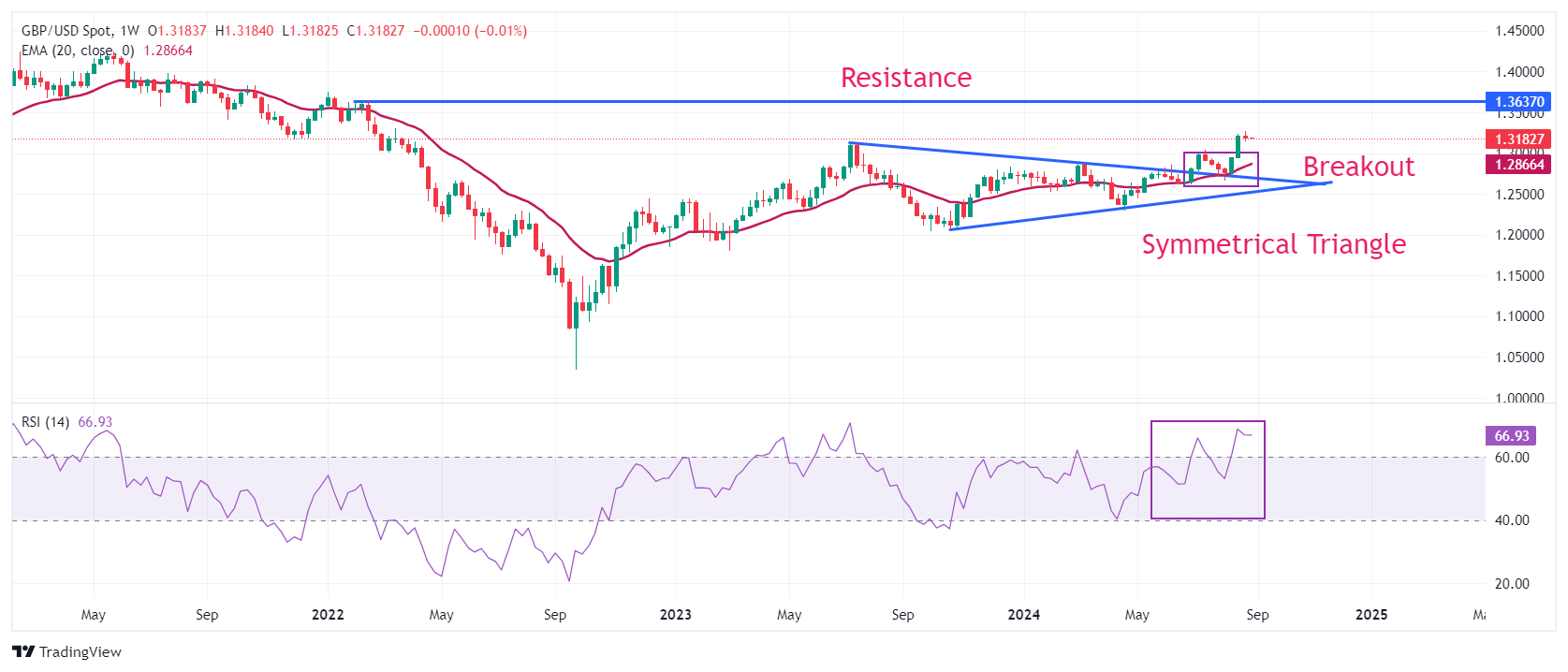Pound Sterling rises above 1.3150 ahead of US core PCE inflation
- The Pound Sterling bounces back from 1.3150 as the US Dollar trades subdued ahead of US core PCE inflation data for July.
- Investors see the annual core PCE inflation accelerating to 2.7% from 2.6% in June.
- The policy-easing spell from the BoE is expected to be slower than that of its major peers.
The Pound Sterling (GBP) finds cushion near 1.3150 after a two-day sell-off against the US Dollar (USD) in Friday’s London session. The GBP/USD pair gains ground as the US Dollar exhibits a subdued performance in the countdown to the release of the United States (US) Personal Consumption Expenditure Price Index (PCE) data for July, which will be published at 12:30 GMT. The US Dollar Index (DXY), which tracks the Greenback’s value against six major currencies, falls slightly to 101.30.
Economists expect that the annual core PCE inflation, which excludes volatile food and energy prices, rose at a higher pace of 2.7% from June’s reading of 2.6%, with monthly figures growing steadily by 0.2%.
Historically, the impact of the PCE inflation data has been high as it is the Federal Reserve’s (Fed) preferred inflation gauge for decision-making on interest rates. This time, the impact of the underlying inflation data is expected to remain limited on the US Dollar and market speculation for the Fed’s interest rate cut path this year unless there is a significant deviation from estimates and the former release.
With increased confidence that inflation is on track to sustainably decline to the Fed’s target of 2%, officials are now worried about growing risks to US labor market strength. “The balance of risks to our mandate has changed”, said Fed Chair Jerome Powell last week in his speech at the Jackson Hole (JH) Symposium. The comments from some other Fed policymakers have also indicated that the central bank won’t hesitate to reduce its key borrowing rates aggressively in case of further evidence of a sharp deterioration in the labor market emerges.
Currently, financial market participants expect that the Fed is almost certain to start reducing interest rates in September. However, traders remain split over the likely size by which the Fed will begin its long-awaited policy-easing. According to the CME FedWatch tool, the probability of a 50-basis-points (bps) interest-rate reduction in September is 32.5%, while the rest are favoring a cut by 25 bps.
Daily digest market movers: Pound Sterling outperforms its major peers
- The Pound Sterling performs strongly against its major peers on Friday, with investors gaining confidence that the policy-easing cycle by the Bank of England (BoE) will be gradual in the remainder of the year compared with that of its peer central banks.
- According to money market pricing data, the BoE is expected to cut interest rates by 40 bps in the remaining year, while the European Central Bank (ECB) is projected to do the same by 65 bps, Reuters reported. In the same time frame, the Fed is estimated to cut its key borrowing rates by 100 bps, according to the CME FedWatch tool.
- Firm speculation for BoE’s shallow policy-easing cycle is the result of the improved economic outlook in the United Kingdom (UK). In July, the International Monetary Fund (IMF) raised the Gross Domestic Product (GDP) target for this year to 0.7%. Fiscal plans of the new Labour government led by Prime Minister Keir Starmer, which include planning reform and closer trade ties with the European Union, will prompt economic activity, analysts at Goldman Sachs said.
Technical Analysis: Pound Sterling finds cushion near 1.3150

The Pound Sterling rebounds after a mild corrective move to near 1.3150 against the US Dollar. The near-term appeal of the GBP/USD pair remains firm as it holds the breakout of the Rising Channel chart formation on the weekly time frame. If bullish momentum extends, the Cable is expected to rise towards the psychological resistance of 1.3500 and the February 4, 2022, high of 1.3640 after breaking above a fresh two-and-a-half-year high of 1.3266 against the US Dollar.
The upward-sloping 20-week Exponential Moving Average (EMA) near 1.3000 suggests a strong upside trend.
The 14-period Relative Strength Index (RSI) oscillates in the bullish range of 60.00-80.00, suggesting a strong upside momentum. Still, it is close to overbought levels at around 70.00, increasing the chances of a corrective pullback. On the downside, the psychological level of 1.3000 will be the crucial support for the Pound Sterling bulls.
Pound Sterling FAQs
The Pound Sterling (GBP) is the oldest currency in the world (886 AD) and the official currency of the United Kingdom. It is the fourth most traded unit for foreign exchange (FX) in the world, accounting for 12% of all transactions, averaging $630 billion a day, according to 2022 data. Its key trading pairs are GBP/USD, aka ‘Cable’, which accounts for 11% of FX, GBP/JPY, or the ‘Dragon’ as it is known by traders (3%), and EUR/GBP (2%). The Pound Sterling is issued by the Bank of England (BoE).
The single most important factor influencing the value of the Pound Sterling is monetary policy decided by the Bank of England. The BoE bases its decisions on whether it has achieved its primary goal of “price stability” – a steady inflation rate of around 2%. Its primary tool for achieving this is the adjustment of interest rates. When inflation is too high, the BoE will try to rein it in by raising interest rates, making it more expensive for people and businesses to access credit. This is generally positive for GBP, as higher interest rates make the UK a more attractive place for global investors to park their money. When inflation falls too low it is a sign economic growth is slowing. In this scenario, the BoE will consider lowering interest rates to cheapen credit so businesses will borrow more to invest in growth-generating projects.
Data releases gauge the health of the economy and can impact the value of the Pound Sterling. Indicators such as GDP, Manufacturing and Services PMIs, and employment can all influence the direction of the GBP. A strong economy is good for Sterling. Not only does it attract more foreign investment but it may encourage the BoE to put up interest rates, which will directly strengthen GBP. Otherwise, if economic data is weak, the Pound Sterling is likely to fall.
Another significant data release for the Pound Sterling is the Trade Balance. This indicator measures the difference between what a country earns from its exports and what it spends on imports over a given period. If a country produces highly sought-after exports, its currency will benefit purely from the extra demand created from foreign buyers seeking to purchase these goods. Therefore, a positive net Trade Balance strengthens a currency and vice versa for a negative balance.

